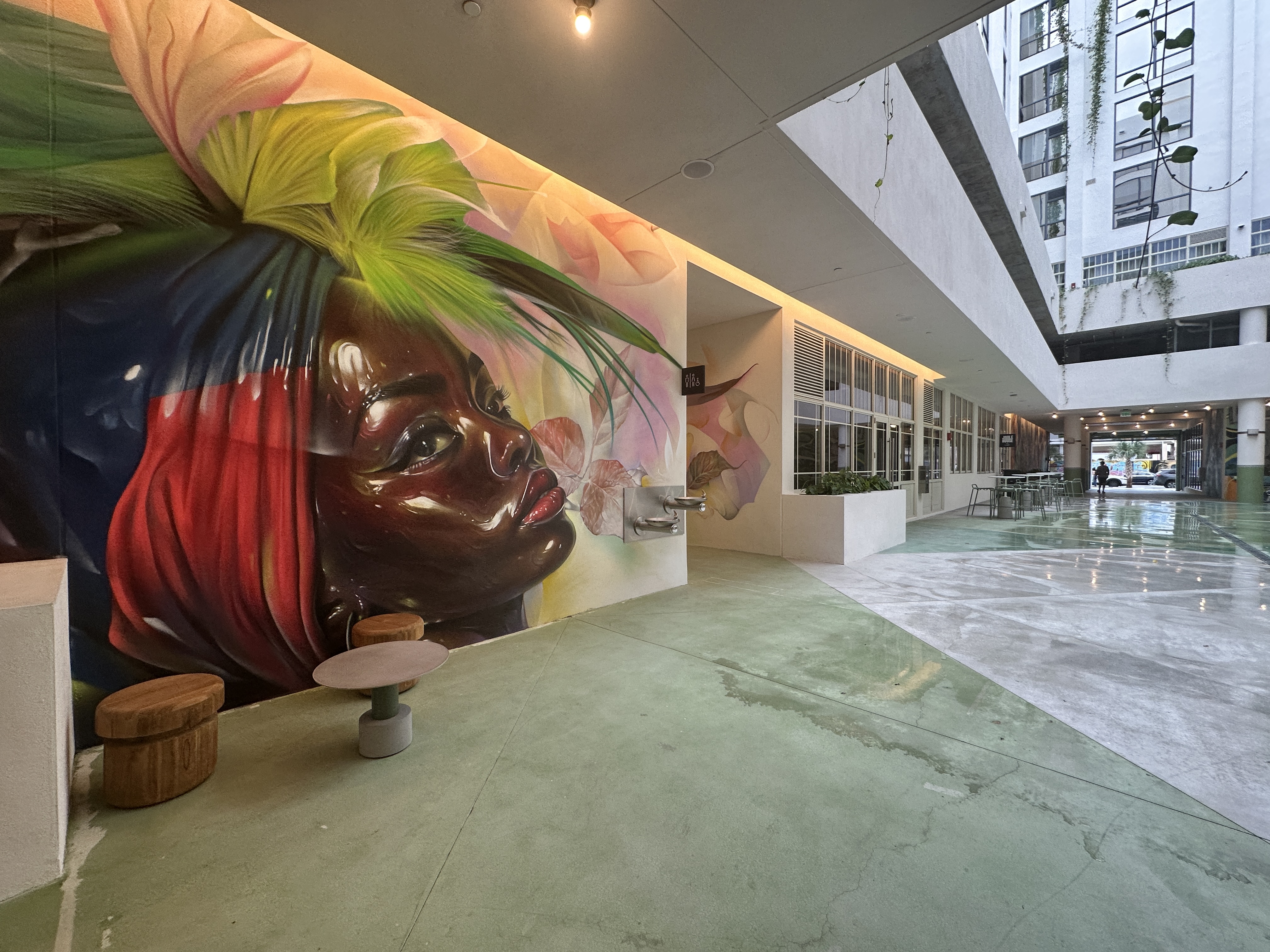
Photo by Jill Weisberg

Audio By Carbonatix
Step into the open-air courtyard occupied by Wynwood’s Calle Collective mural gallery, tucked inside Joule House on NW First Ave., and you’re enveloped in bright colors and striking imagery. On the surface, it’s no different from the many mural-covered walls seen throughout the neighborhood, but deeper down, there’s a glimmer of hope that local artists are being called back to the place they once called home.
Calle Collective is the latest art-forward experiment from developer Fisher Brothers, in collaboration with WxllSpace, the Miami-based platform that connects artists with available mural space. The paseo features 19 works by Miami artists, transforming the building’s central courtyard into an immersive gallery that’s free to visit and open to the public daily.
If that sounds like developer-speak, it kind of is. But to give credit where it’s due, this is a rare example of a project in which including local artists wasn’t just an afterthought.
Wynwood’s story has become all too common in cities around the world: A graffiti mecca becomes an Instagram backdrop, then becomes an open-air shopping mall. Artists used to sneak around to paint the walls in the dead of night here, facing the risk of being arrested.
This year, make your gift count –
Invest in local news that matters.
Our work is funded by readers like you who make voluntary gifts because they value our work and want to see it continue. Make a contribution today to help us reach our $30,000 goal!
“Back then, you didn’t paint for exposure,” recalls Quake, a participating artist who’s been part of Miami’s graffiti scene since the mid-’90s. “You painted because you had to. It was part of your identity, not a career path.”
Now, with mainstream acceptance of the art form, more and more graffiti artists have found opportunities to turn their passion into a viable career option. The same walls that once got artists chased off are curated, sponsored, and monetized, usually by people who had nothing to do with the culture they’re cashing in on.
“When I moved here in ’99, the city had just cleaned up after the big graffiti busts, and there was hardly any paint on the highways,” shares Remote, another Miami-based artist. “Wynwood was still bubbling under the surface. I didn’t realize it at the time, but it was like fate. I came here right when Miami was starting to find its artistic identity.”
But in the rush to brand the neighborhood as an art destination, much of the payoff went to visiting muralists, while Miami’s own talent often got scraps. Calle Collective feels like a course correction; a small, yet deliberate attempt to put the spotlight — and the paychecks — back on the locals who have paid their dues.
“They really set themselves apart because they embraced art in a big way, not just a token mural or two,” says Remote. “I don’t think there’s another building in the neighborhood with this much work from local artists.”
Quake has spent decades navigating the city’s evolving relationship with graffiti, co-founding Cushy Gigs, a creative agency that helps artists translate their work into commercial projects without losing their edge. He’s no stranger to mural jobs that come with brand notes or creative constraints, but for the Joule House project, he says, it was different.
“The first thing I gave them was approved; no notes, no pushback,” he says. “It was built from my freestyles, those muscle-memory movements I’ve built over years of painting graffiti.” He admits it’s not always palatable to everyone, but he found it received warmly in this case.
That freedom to create without filters is crucial for nurturing an environment that allows artists to thrive. Calle Collective isn’t pretending to fix Wynwood’s history of artistic displacement, but by trusting local artists to create on their own terms, it offers a rare sense of belonging in a neighborhood that’s grown increasingly foreign to the people who built it.
“While we were in Joule House, that old community, that 2009, 2010, 2011 vibe came back for a bit,” Quake says. “Artists were just showing up, pushing each other, eating together, painting together, throwing around ideas, complaining, commiserating. It was a microcosm of the Miami art community. And a lot of that had to do with Jill and the people she chose. She did a really good job curating it.”
Jill Weisberg’s curation on behalf of WxllSpace leans local, and intentionally so. Out of the 30 artists involved, 25 are from the city, including a lineup that reads like a roll call of Miami styles rather than a showcase of brand names. The publicly accessible work spans the exterior and the paseo, and the Calle Collective gallery itself features 15 Miami artists. Additional pieces live in semi-private zones like the lobby and pool deck. In other words, the headline art is actually for the neighborhood, not just for residents and a brochure.
Still, even as Calle Collective gives artists a platform, the question lingers: What happens after the paint dries? None of this guarantees the long game. Whether the programming invites the neighborhood in, and whether tenants foster the culture rather than price it out, remains to be seen. But for now, the early boxes most projects strike out on are being checked: a local-first roster, visible public access, and a curator with a track record of fighting for Miami artists. If that commitment holds, Calle Collective could serve as a template for how Wynwood builds with its scene, rather than merely on top of it.